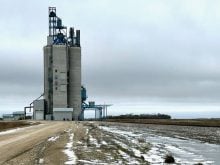Discoveries of BSE in Canadian cattle could end in two or three years and the disease could be eradicated shortly afterward, according to those monitoring BSE developments in North America and Europe.
The predictions are based on an assumption that BSE does not occur randomly and spontaneously at low levels and that feed restrictions in Canada will halt its spread.
“All the models would tell us that even with the existing feed ban, we may not be able to detect BSE much beyond 2006 or 2007, if it has done everything we think it has done,” said Brian Evans, chief veterinarian for the Canadian Food Inspection Agency.
Read Also

Farming Smarter to hold Agronomy Battles series
Southern Alberta non-profit research institute hope grassroots sessions with producers help focus future research on cover crops, strip tillage and herbicide resistance
Canada’s feed regulations prohibit feeding of ruminant protein to other ruminants. Feeding of specified risk materials, such as brains and spinal cord material from ruminants, is included in the ban.
The federal government is pursuing a ban on the feeding of those risk materials to other livestock, such as poultry and swine. That would address the risk that ruminants could accidentally be fed poultry or swine rations containing the risky material.
“By bringing in a new measure, what we would be doing is saying we’re not going to find that one animal springing up three or four years down the road that would create doubt in the system,” Evans said.
If Canada is to rebuild its cattle and beef exports it must demonstrate that BSE occurred in the Canadian cattle herd at only low levels and that the country is well on its way to eradicating the disease.
Even if eradication was to occur within the next year or two, it would still take a few years of ongoing surveillance within the cattle herd to confirm the disease had been eliminated, Evans said.
Canada implemented a ban on feeding ruminant protein to other ruminants in 1997. There are still cattle in the Canadian herd that were born before that ban and that could have been exposed to feed contaminated with the disease.
Eradication of BSE will depend largely on how long it takes for those cattle to be culled from the Canadian herd, which is affected by the ability to increase slaughter capacity.
“We’re well on the way to having this disease eradicated,” said Chris Clark, an assistant professor of large animal medicine at the Western College of Veterinary Medicine in Saskatoon. “We’re probably halfway through our eradication phase.”
In Britain, where BSE became endemic in the cattle herd, the ban on feeding ruminant matter to ruminants had the most significant effect on curtailing the disease, said Clark.
Canada never relied as heavily on meat and bone meal for protein in cattle rations because of the greater availability of protein from alfalfa and soy meal, he said.
“The thing to recognize is that the situation Britain faced in dealing with BSE is very, very different from what Canada is facing today.
“They were dealing with an epidemic that was pretty much out of control. They were also dealing with a country in which the feeding of rendered meat and bone meal, particularly of ruminant origin, was extremely widespread within the ruminant industry.”
A leading British researcher on spongiform encephalopathies suspects cases can occur spontaneously in all mammalian species at very low levels as a result of mutations. Excluding those kinds of possibilities, Clark estimated Canada could have BSE eradicated from its cattle herd by 2010.
“We are looking very, very hard for this disease and it’s apparent we’re finding very, very little,” he said, referring to the results of a national ongoing BSE surveillance program that would detect the disease at a prevalence level as low as one infected animal in a million.














